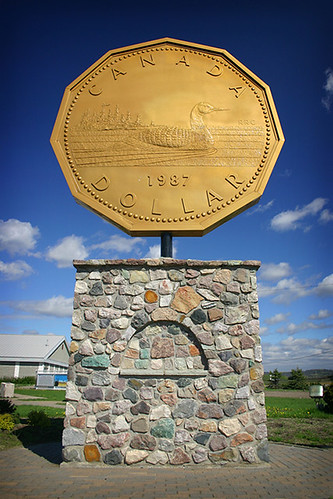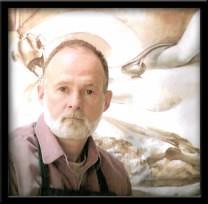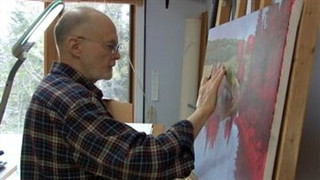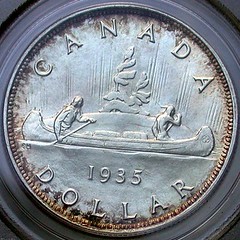
PREV ARTICLE
NEXT ARTICLE
FULL ISSUE
PREV FULL ISSUE
LOONIE DESIGNER ROBERT-RALPH CARMICHAEL, 1937 - 2016
On July 18, 2016 The Canadian Press published an article about the passing of the deisgner of the iconic Canadian
"Loonie" dollar, Robert-Ralph Carmichael. The article was unillustrated; I added a portrait from his online obituary. -Editor
Artist Robert-Ralph Carmichael's image of a solitary loon was introduced in 1987, when Canada replaced its one dollar bill with a coin. It was "the most significant change to Canada's coinage system in over 50 years," the Royal Canadian Mint said. "Since that time, Mr. Carmichael's design has appeared on over one billion one-dollar coins," the mint said in a statement. "We thank him for his remarkable contribution in creating what has become a true Canadian symbol." Carmichael died Saturday at a hospice in Sault Ste. Marie, Ont. He was 78 years old. He also produced designs for some of the mint's commemorative coins and created a loon stamp for Canada Post. When the mint originally announced it would replace its one dollar bill with a coin as a cost-cutting measure, it was supposed to carry a version of a silver dollar from 1935 that was produced to mark the silver jubilee of King George V. The silver dollar's design, which featured an aboriginal man and a voyageur paddling a canoe laden with packages, paid tribute to Canada's historical fur trade. But when the mint decided to reproduce the design, the dies that would have been used to cast the new coins were lost in transit between Ottawa and the mint's production facility in Winnipeg. Worried that counterfeit versions of the voyageur coin might surface, the mint selected a new design — Carmichael's image of a loon — and released the new dollar coins on June 30, 1987. In 1992, Carmichael's hometown of Echo Bay, Ont., near Sault Ste. Marie, erected a giant Loonie monument in tribute to the artist's design. To read the complete article, see:
To read the Carmichael's online obituary, see:
Here's more from an article from the CBC News. -Editor

"Mr. Carmichael's loonie design has stood the test of time due to its simplicity in depicting an icon of Canadian wildlife," said a statement issued by the Royal Canadian Mint on Monday. "The introduction of the one-dollar coin in 1987 was the most significant change to Canada's coinage system in over 50 years. We thank him for his remarkable contribution in creating what has become a true Canadian symbol." Figures from the mint show that well over a billion loonie coins have been produced since 1987. Carmichael's initials appear near the bird's beak. While the loonie was Carmichael's best known numismatic work, he designed more than a dozen other coins for the mint, including several gold and commemorative coins. In a 2012 interview with the Sault Star, Carmichael said his design for the loonie was the first one the mint accepted after 10 years of submitting proposals. "The loon dollar was the first, and I suppose the greatest," he told the newspaper. "You couldn't ask for a better introduction to having your work produced as a coin than that one. Everything followed that."
Carmichael was a successful artist who showed his drawings and paintings in dozens of group and solo exhibitions across Canada. His work is featured in the permanent collections of many art galleries and in many private collections. To read the complete article, see:
Here's a piece about the "Big Loonie". -Editor
When driving east from Sault Ste. Marie, Highway 638 offers a scenic alternative to the more heavily travelled Highway 17. Spanning 52 km from Echo Bay to Bruce Mines, this secondary highway meanders its way through varied terrain, offering a fresh view at every turn. Heading east from Echo Bay, the highway is flanked by vistas of rocky ridges as it dips into the pastoral lowlands of Sylvan Valley before entering a forested stretch north of McCarrel Lake. From here, the road passes by a handful of small farms nestled between tree-covered hills as the route passes through the tiny settlement of Leeburn. The highway then veers south at its intersection with Poplar Dale Road, then passes through some rugged terrain as is skirts between Rock Lake and Dunns Valley. The road then flattens out as it passes through sprawling farmland near the small communities of Rydal Bank and Bruce Station, before finally reaching its terminus at its intersection with Highway 17 at Bruce Mines. 
At the western terminus of Highway 638 lies the town of Echo Bay, which is home to the “Big Loonie.” Officially known as the Loon Dollar Monument, this roadside attraction was erected in 1992 in recognition of local resident Robert-Ralph Carmichael, who created the design for Canada’s one-dollar coin in 1987. To read the complete article, see:
The story of the missing Voyager dies was discussed in The E-Sylum back on 2008. -Editor
One die carried the image of the Queen and the other noted sculptor and artist Emanuel Hahn's iconic "voyageur canoe" scene that had graced Canada's first silver dollar and other coins since 1935. The plan was to introduce a new bronze-coloured voyageur canoe dollar coin in early 1987 and begin a two-year phase-out of the old green-and-white $1 bill. But 11 days later, on Nov. 14, distressed mint officials in Winnipeg called in the Mounties -- the two steel dies had never arrived from Ottawa. To read the earlier E-Sylum article, see:

Wayne Homren, Editor The Numismatic Bibliomania Society is a non-profit organization promoting numismatic literature. See our web site at coinbooks.org. To submit items for publication in The E-Sylum, write to the Editor at this address: whomren@gmail.com To subscribe go to: https://my.binhost.com/lists/listinfo/esylum All Rights Reserved. NBS Home Page Contact the NBS webmaster 
|


